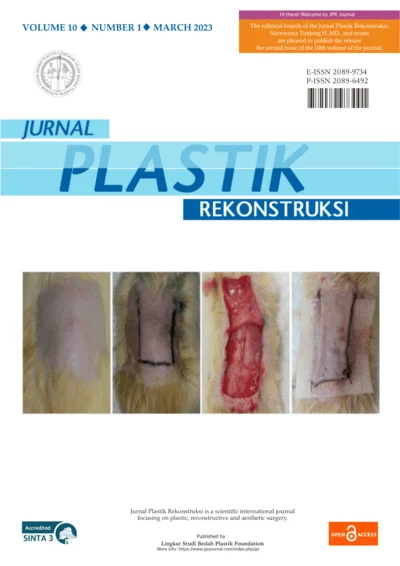Predicting Free Flap Viability: Integrating Lactate and Glucose Measurements with Artificial Intelligence
Abstract
Data Availability
References
- Knoedler S, Hoch CC, Huelsboemer L, Knoedler L, Stögner VA, Pomahac B, KaukeNavarro M, Colen D. Postoperative free flap monitoring in reconstructive surgery-man or machine? Front Surg. 2023 Feb 22;10:1130566. doi: 10.3389/fsurg.2023.1130566. PMID: 36911625; PMCID: PMC9992807.
- Abdulfattah Altam, et al. Role of microsurgical free flap reconstruction in managing complex wound: a retrospective cross-sectional study. Pan Afr Med J. 2022;43:211. doi: 10.11604/pamj.2022.43.211.36595.
- Friedrich JB, Pederson WC, Bishop AT, Galaviz P, Chang J. New workhorse flaps in hand reconstruction. Hand (N Y). 2012 Mar;7(1):45-54. doi: 10.1007/s11552-011-9385-x. Epub 2012 Jan 4. PMID: 23449685; PMCID: PMC3280375.
- Gürlek A, Kroll SS, Schusterman MA. Ischemic time and free flap success. Ann Plast Surg. 1997;38(5):503-5. doi: 10.1097/00000637-19970500000010.
- Lim BJ, Shin JY, Roh SG, Lee NH, Chung YK. Clinical analysis of factors affecting the failure of free flaps used in head and neck reconstruction. Arch Craniofac Surg. 2023 Aug;24(4):159-66. doi: 10.7181/acfs.2023.00325. Epub 2023 Aug 20. PMID: 37654235; PMCID: PMC10475704.
- Al Deek NF, Wei FC, Mardini S. Current trends in lower extremity reconstruction. Plast Reconstr Surg. 2018;141(2):306e-316e. doi: 10.1097/PRS.0000000000004052.
- Zhang YX, Zhang YF, Xie HQ, Kang YM. Clinical evaluation of flap failure: What’s new in clinical diagnostic methods? Ann Plast Surg 2020;85(6):640-6. doi: 10.1097/SAP.0000000000002542.
- David JA, Brown KT, Smith RL, Wilson M. Advances in flap reconstruction techniques. J Reconstruct Surg. 2017;29(4):2508. doi: 10.1016/j.jrs.2017.02.005.
- Odorico A, De Stefano L, Rossi G. Impact of patient factors on flap survival rates in reconstructive surgery. Plast Reconstr Surg Glob Open. 2022;10(2). doi: 10.1097/GOX.0000000000003962.
- Shen H, Li Z, Wang X. Postoperative management and monitoring in flap surgery: Current practices and future directions. Ann Plast Surg. 2021;86(3):310-6. doi: 10.1097/SAP.0000000000002765.
- Claes KE, Rohrich RJ. Prevention and management of flap complications: Flap monitoring and salvage techniques. Plast Reconstr Surg Glob Open. 2021;9(3). doi: 10.1097/GOX.0000000000003448.
- Khansa I, Janis JE, Khansa L. Understanding the limits of muscle flaps in reconstructive surgery: A critical review. Ann Plast Surg. 2016;77(1):83-90. doi: 10.1097/SAP.0000000000000648.
- Jandali Z, Nelson JA. Factors affecting flap success in reconstructive surgery. Plast Reconstr Surg. 2020;145(5):903e-911e. doi: 10.1097/PRS.0000000000006811.
- Venkatasami R, Patel PP, Kumar S. Flap failures in reconstructive surgery: Analysis of causes and preventive measures. J Plast Reconstr Aesthet Surg. 2015;68(8):1135-41. doi: 10.1016/j.bjps.2015.04.005.
- Kishi K, Fujikawa M, Nakajima H. Novel techniques in flap surgery: A comprehensive review. Plast Reconstr Surg. 2018;141(5):765e-777e. doi: 10.1097/PRS.0000000000004312.
- Stephan A, Müller D, Schmidt M. Strategies to reduce flap failure in reconstructive surgery: A systematic review. J Plast Reconstr Aesthet Surg. 2023;76(2):264-72. doi: 10.1016/j.bjps.2022.08.018.
- Choudhary AK, Singh AI, Das SI, Singh LO, Singh NS. Role of flap blood glucose measurement in monitoring of flap incorporating skin and to detect flap congestion and flap salvage. J Med Soc. 2020;34(2):106-10. doi: 10.4103/jms.jms_127_20.
- Chebl RB, Almeida MF, de Faria JC. Risk factors for flap failure in reconstructive surgery: A retrospective analysis. J Plast Surg Hand Surg. 2017;51(3):191-7. doi: 10.1080/2000656X.2017.1282678.
- Boissard A, O’Grady S, Lau H. Monitoring of flap perfusion using lactate measurements. J Reconstruct Microsurg. 2019;35(5):347-54.
- Noland SS, et al. The utility of lactate monitoring in postoperative care of free flaps. Microsurgery. 2016;36(1):63-7.
- Tsuchiya S, et al. Lactate monitoring as an early indicator of free flap failure. Ann Plast Surg. 2014;73(1):59-63.
- Couture F, et al. Lactate as a biomarker in microvascular free tissue transfer: A systematic review. J Plast Reconstr Aesthet Surg. 2020;73(2):349-55.
- Henault B, Pluvy I, Pauchot J, Sinna R, Labruère-Chazal C, Zwetyenga N. Capillary measurement of lactate and glucose for free flap monitoring. Ann Chir Plast Esthet. 2014;59(1):15–21. doi: 10.1016/j.anplas.2013.08.001.
- Phypers B, Pierce JT. Lactate physiology in health and disease. Continuing Education in Anaesthesia Critical Care & Pain. 2006;6(3):128–32. doi: 10.1093/bjaceaccp/mkl018.
- Guillier D, Moris V, Cristofari S, Gerenton B, Hallier A, Rizzi P, Henault B, Zwetyenga N. Monitoring of myocutaneous flaps by measuring capillary glucose and lactate levels. Ann Plast Surg. 2018;80(4):416–23. doi: 10.1097/SAP.0000000000001313.
- Nosrati H, Nosrati M. Artificial intelligence in regenerative medicine: applications and implications. Biomimetics. 2023;8(5):442. doi: 10.3390/biomimetics8050442.
- Singh K, Shah S, Mittal RK, Garg R. Role of lactate measurement in flap monitoring: a useful adjunct. Indian J Plast Surg. 2023;56(4):3449. doi: 10.1055/s-0043-1769111.
- Kiwan O, Al-Kalbani M, Rafie A, Hijazi Y. Artificial intelligence in plastic surgery, where do we stand? JPRAS Open. 2024;42:234-43.
- Spoer DL, Kiene JM, Dekker PK, Huffman SS, Kim KG, Abadeer AI, Fan KL. A systematic review of artificial intelligence applications in plastic surgery: looking to the future. Plast Reconstr Surg Glob Open. 2022 Dec 2;10(12). doi: 10.1097/GOX.0000000000004608. PMID: 36479133; PMCID: PMC9722565.
- Singh K, Shah S, Mittal RK, Garg R. Role of lactate measurement in flap monitoring: a useful adjunct. Indian J Plast Surg. 2023 Jun 1;56(4):344-9. doi: 10.1055/s-0043-1769111. PMID: 37705814; PMCID: PMC10497328.
Journal Info
 |
Editor-in-Chief: dr. Narottama Tunjung, Sp.B.P.R.E., F.L.
Frequency: 2 issues per year (March & September)
National Accreditation: Sinta 3 Email: info@jprjournal.com
|









